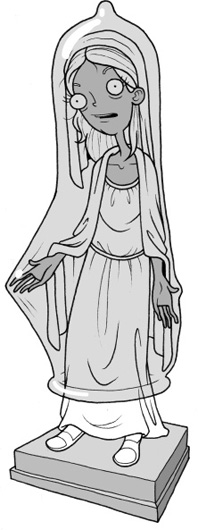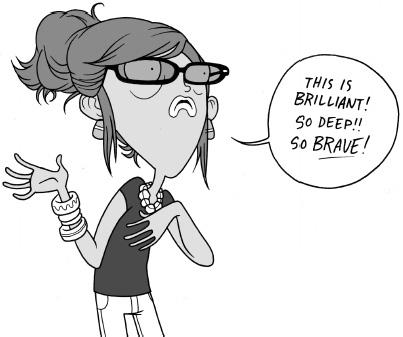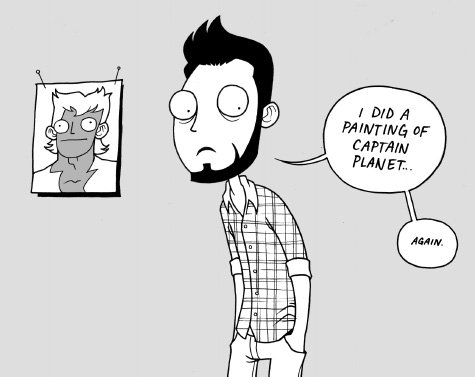
I wasn’t paying attention when Zoe started explaining her project to the class. It was mid-April and the weather was strangely warm for Boston. School was the last thing on my mind, especially since I was set to graduate in a few weeks. The students were gathered in one of the stuffy ground-floor art rooms, fidgety and restless as each person presented their final undertakings. Over the past hour the quality of the work had been steadily declining, since the kids with the most impressive projects had all volunteered to go first. Prior to Zoe, a moody guy with floppy hair covering half his face had discussed his “work”: several pieces of dirty cardboard that he’d pinned to the wall.
The signs and his subsequent explanation received a warm enough response from the professor and the class, but by the time he was finished I’d mostly checked out, content instead to stare out the window and watch a bag lady with a single giant dreadlock rummage through a trash can. She’s probably looking for her cardboard sign, I thought.

When I’d arrived at college, I couldn’t wait to join a community bursting at the seams with artists like myself. But four years in art school had inspired a degree of apathy in me, at least regarding certain facets of the art world. Perhaps I’d simply grown tired of my professors responding so positively to what I deemed to be total bullshit. Several weeks before, a student had spilled paint on a white sheet, then ridden his skateboard back and forth through the mess, and the response from the school’s faculty had been alarmingly favorable. I’d overheard one teacher in the hall saying, “This is going to be huge. They’ll be knocking down his door after this piece goes public.” I didn’t know who “they” were, but by that point I’d accepted the possibility that maybe I just didn’t have my finger on the pulse of the art world. While I’d always received positive feedback on my own work, my stuff was more illustrative and usually humorous, and even if my professors never said so outright, the general attitude toward illustration and cartooning at my school seemed to be that it was a lesser art. This was disheartening, if not outright insulting, as I’d always taken my work seriously, even when it was silly or absurd.
The kid with the signs unpinned them from the wall, crammed them into his messenger bag, and Zoe was called on to present her final piece for critique. Out of the corner of my eye I noticed her set something on a rickety metal stool. Her explanation was brief and matter-of-fact, and at first I wasn’t sure I’d heard her right.
“I put a condom on the Virgin Mary,” she said flatly.
Her words took a moment to sink in. I turned my attention toward the front of the room. Sitting on the stool next to Zoe was, in fact, a cheap plastic figurine of the Virgin Mary—the kind you’d find at a dollar store—and it was sheathed in a latex condom. I wasn’t sure if she was serious or if it was just a prank. It seemed she’d spent all of forty seconds slapping it together. I glanced at her face for a sign that she was joking, but found none.
Nobody spoke. I assumed it was because everyone was as baffled as I, but I couldn’t be sure, as everyone’s face held a similarly blank expression. The professor kindly asked Zoe to explain the piece.

“Well, like, it’s meant to be a criticism of the Virgin myth and a commentary on the absurdity of divine impregnation.” Zoe shifted her weight a bit and cocked her head, as if she didn’t quite believe herself. I sort of got the idea, and might’ve even put some stock in the concept, but what it boiled down to was that Zoe had crammed a tacky figurine into a condom and called it a day. I’d seen this kind of thing a hundred times before. Freshman year, the kid across the hall from me had made a mural out of Cheerios and Froot Loops, and we were all pretty sure he’d forgotten about the project entirely and scrambled to make something from materials in his dorm room in the hour before class. That sort of behavior was understandable for a new student, but this was supposed to be the culmination of a semester’s worth of work by a senior. It was supposed to have taken a week to complete at the very least. I expected the professor to tear Zoe a new one for wasting everyone’s time, but instead she clutched her chunky stone necklace and gushed about it.

“Tampon in a teacup…” I whispered to myself, though apparently louder than I’d realized, because it caught the attention of the professor.
“Adam, do you have anything you want to add about Zoe’s piece?”
“Oh, uh, no,” I stammered, “I was just saying, uh… there’s this movie, and a girl puts a tampon in a teacup as a commentary about the expectations society places on women, or something. This just, uh, reminded me of that. I guess.” The movie I was referring to was Ghost World, and the tampon-in-a-teacup sculpture is meant to be ridiculous and pretentious. I was sure I was about to be outed as the class jerk, but nobody seemed to get the reference.
“It’s almost, like, defiant in a way,” said one girl, her head tilted thoughtfully at the figurine. Other students murmured in agreement, someone else adding, “Yeah, it’s kind of daring.” I rolled my eyes. The professor added a few marks in her grade book, and then it was my turn to share. For a moment I considered leaving class and taking a failing grade on the project. My work was far less conceptual, and I feared a backlash. I pinned several paintings to the wall and turned to face the class.

Since Netflix had recently been inexplicably suggesting shows from my childhood, I’d been on a ’90s cartoon kick for a few weeks. I had started painting characters from the shows as a sort of warm-up, but then a larger idea had developed. For my final project I’d decided to paint characters from Captain Planet, but in an art nouveau style, in an attempt to juxtapose art in the 1890s with animated media in the 1990s. “Well, I feel that art nouveau has become homogenized and mundane to the point of every dorm room having a reproduction of Tournée du Chat Noir avec Rodolphe Salis, or some reprinted vintage perfume ad,” I explained. “So I’ve taken that notion and drawn parallels with how kids’ cartoons in the nineties degraded into little more than half-hour commercials designed to sell toys.” I had worked hard and thought my final project was rad, but my professor wasn’t so sure. She grilled me about my paintings.
“I wonder about the relevance these works have in the grand scheme of things,” she told me. “I think you need time to let your talents gestate. Cartoons might not be the best subject matter for you.” She turned back to the class.
She had missed the point of my project. Behind her, through the window, I noticed that the bag lady with the giant dreadlock had taken her boob out and was holding it in one hand while she yelled at a bicycle. I wondered if I was living in a less crazy world than she was. I imagined that if the homeless lady had been standing indoors instead of out, she would have been considered a creative genius by my professor.
As I stood on the subway platform waiting for the Green Line train after class, I tried my best to feel anger about my professor’s comments on my artwork, but the truth was I couldn’t muster anything. I’d grown jaded, and the complacency I felt scared me. For the first time in years, I was worried about my future, and it wasn’t because my professor hadn’t responded positively to my paintings. I’d learned years ago to not take critiques personally, and I had no real desire to make a living displaying my work in galleries anyway. But the fact that the skateboard/paint piece and the prophylactic Virgin Mary were considered successes made me question my chosen field. I’d always been hopeful that I could incorporate my creativity into a more standard job–like scenario—Cake decorating! Painting children’s faces at the county fair!—but now that I was thinking about it seriously I realized my options as an artist might not be as plentiful as I’d fantasized. For a split second, I toyed with the idea of grad school, but I was weary of being in school and felt eager to embark on a new chapter of my life. I was sick of Boston too, with its subzero winters and Red Sox fans charging the streets with their faces made up in red and white. Up until this point, I hadn’t given a lot of thought to what I’d do after college. Most of my friends were staying in Boston or migrating south to New York, and I had planned to do the same, hoping to find a job in one place or the other. But on that platform, I suddenly knew I needed a drastic change of scenery.
That night in my room, I started plotting my escape. I turned to the back of an old geography textbook and scanned over a map of the United States: I wanted to go far away. The West Coast seemed like the logical leap, but where to? Southern California was out (earthquakes!), as was Seattle (I refuse to live in the same city as Sir Mix-a-Lot). I briefly considered Hawaii, but that fantasy faded when I remembered that they have giant cockroaches and none of their Taco Bells are open twenty-four hours, which I personally believe should be classified as a crime against humanity. San Francisco was too expensive, British Columbia was too cold. I wanted to be in a larger city, so the only remaining option was Portland, Oregon—a city that I had never, up until that moment, given a passing thought to. I grabbed my computer and powered it up. When I Googled “Portland, Oregon” pictures of food carts, lush green parks, and crystal blue skies popped up on my screen. They got pretty trees, I mused. I imagined Portland shining like a beacon, beckoning to me from a distant horizon. I pictured myself growing a giant beard and trading in all my existing clothes for soft, comfy flannel. And just like that, I was Portland-bound.
